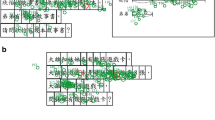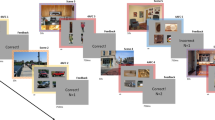Abstract
Eye movement studies are subject of interest in human cognition. Cortical activity and cognitive load impress eye movement influentially. Here, we investigated whether fluid intelligence (FI) has any effect on eye movement pattern in a comparative visual search (CVS) task. FI of individuals was measured using the Cattell test, and participants were divided into three groups: low FI, middle FI, and high FI. Eye movements of individuals were then recorded during the CVS task. Eye movement patterns were extracted and compared statistically among the three groups. Our experiment demonstrated that eye movement patterns were significantly different among the three groups. Pearson correlation coefficients between FI and eye movement parameters were also calculated to assess which of the eye movement parameters were most affected by FI. Our findings illustrate that saccade peak velocity had the greatest positive correlation with FI score and the ratio of total fixation duration to total saccade duration had the greatest negative correlation with FI. Next, we extracted 24 features from eye movement patterns and designed: (1) a classifier to categorize individuals and (2) a regression analysis to predict the FI score of individuals. In the best case examined, the classifier categorized subjects with 68.3% accuracy, and the regression predicted FI of individuals with a 0.54 correlation between observed FI and predicted FI. In our investigation, the results have emphasized that imposed loads on low FI individuals is greater than that of high FI individuals in the cognitive load tasks.







Similar content being viewed by others
References
Alotaibi A, Underwood G, Smith AD (2017) Cultural differences in attention: eye movement evidence from a comparative visual search task. Conscious Cogn 55:254–265
Bahill AT, Clark MR, Stark L (1975) The main sequence, a tool for studying human eye movements. Math Biosci 24:191–204
Baratloo A, Hosseini M, Negida A, Ashal GE, Ashal GE (2015) Part 1: simple definition and calculation of accuracy, sensitivity and specificity. Emergency 3:2–3
Burch M (2017) Visual analysis of eye movement data with fixation distance plots. In: International conference on intelligent decision technologies, pp 227–236
Cattell RB (1963) Theory of fluid and crystallized intelligence: a critical experiment. J Educ Psychol 54(1):1–22
Cazzato V, Basso D, Cutini S, Bisiacchi P (2010) Gender differences in visuospatial planning: An eye movements study. Behav Brain Res 206(2):177–183
Chuk T, Crookes K, Hayward WG, Chan AB, Hsiao JH (2017) Hidden Markov model analysis reveals the advantage of analytic eye movement patterns in face recognition across cultures. Cognition 169:102–117
Coco MI, Keller F (2014) Classification of visual and linguistic tasks using eye-movement features. J Vis 14(3):11–11
Colby CL, Goldberg ME et al (1992) The updating of the representation of visual space in parietal cortex by intended eye movements. Science 255(5040):90–92
Conway ARA, Cowan N, Bunting MF, Therriault DJ, Minkoff SR (2002) A latent variable analysis of working memory capacity, short-term memory capacity, processing speed, and general fluid intelligence. Intelligence 30(2):163–183
Cowen L, Ball LJ, Delin J (2002) An eye movement analysis of web page usability. In: People and computers XVI-memorable yet invisible, Springer, pp 317–335
Di Stasi LL, Marchitto M, Antolí A, Baccino T, Cañas JJ (2010) Approximation of on-line mental workload index in ATC simulated multitasks. J Air Transp Manag 16(6):330–333
Dix A, van der Meer E (2015) Arithmetic and algebraic problem solving and resource allocation: the distinct impact of fluid and numerical intelligence. Psychophysiology 52(4):544–554
Duchowski AT (2007) Eye tracking methodology. Theory Pract 328:15–27
Fry AF, Hale S (2000) Relationships among processing speed, working memory, and fluid intelligence in children. Biol Psychol 54(1–3):1–34
Gaarder KR (1975) Eye movements, vision, and behavior. Hemisphere Publishing Corporation, Washington DC
Galpin AJ, Underwood G (2005) Eye movements during search and detection in comparative visual search. Percept Psychophys 67(8):1313–1331
Garza R, Heredia RR, Cieslicka AB (2016) Male and female perception of physical attractiveness: an eye movement study. Evol Psychol 14(1):1–16
Goldberg JH, Kotval XP (1999) Computer interface evaluation using eye movements: methods and constructs. Int J Ind Ergon 24(6):631–645
Gray JR, Chabris CF, Braver TS (2003) Neural mechanisms of general fluid intelligence. Nat Neurosci 6(3):316–322
Hayes TR, Henderson JM (2017) Scan patterns during real-world scene viewing predict individual differences in cognitive capacity. J Vis 17(5):23
Hayes TR, Petrov AA (2015) Pupil Diameter tracks the exploration–exploitation trade-off during analogical reasoning and explains individual differences in fluid intelligence. J Cogn Neurosci 28:308–318
Hayes TR, Petrov A, Sederberg PB (2011) A novel method for analyzing sequential eye movements reveals strategic influence on Raven’ s advanced progressive matrices. J Vis 11:1–11
Henn V, Baloh RW, Hepp K (1984) The sleep-wake transition in the oculomotor system. Exp Brain Res 54(1):166–176
Hirvonen K, Puttonen S, Gould K, Korpela J, Koefoed VF, Müller K (2010) Improving the saccade peak velocity measurement for detecting fatigue. J Neurosci Methods 187(2):199–206
Hutton SB (2008) Cognitive control of saccadic eye movements. Brain Cogn 68(3):327–340
Irwin DE, Brockmole JR (2000) Mental rotation is suppressed during saccadic eye movements. Psychon Bull Rev 7(4):654–661
Irwin DE, Brockmole JR (2004) Suppressing where but not what: the effect of saccades on dorsal-and ventral-stream visual processing. Psychol Sci 15(7):467–473
Irwin DE, Carlson-Radvansky LA (1996) Cognitive suppression during saccadic eye movements. Psychol Sci 7(2):83–88
Itoh H (2002) Correlation of primate caudate neural activity and saccade parameters in reward-oriented behavior. J Neurophysiol 89(4):1774–1783
Jellinger KA (2009) The Neurology of Eye Movements 4th edn. Eur J Neurol 16(7):e132–e132
Just MA, Carpenter PA (1976) Eye fixations and cognitive processes. Cogn Psychol 8(4):441–480
Just MA, Carpenter PA (1980) A theory of reading: from eye fixations ot comprehension. Psychol Rev 87(4):329–354
Kirkorian HL, Anderson DR, Keen R (2012) Age differences in online processing of video: an eye movement study. Child Dev 83(2):497–507
Leigh RJ, Zee DS (2015) The neurology of eye movements, vol 90. Oxford University Press, Cary
Meghanathan RN, van Leeuwen C, Nikolaev AR (2015) Fixation duration surpasses pupil size as a measure of memory load in free viewing. Front Hum Neurosci 8:1–9
Momtaz HZ, Daliri MR (2016) Differences of eye movement pattern in natural and man-made scenes and image categorization with the help of these patterns. J Integr Neurosci 15(01):37–54
Munoz DP, Broughton JR, Goldring JE, Armstrong IT (1998) Age-related performance of human subjects on saccadic eye movement tasks. Exp Brain Res 121(4):391–400
Nesbit LL (1981) Relationship between eye movement, learning, and picture complexity. Educ Technol Res Dev 29(2):109–116
Nettelbeck T, Edwards C, Vreugdenhil A (1986) Inspection time and IQ: evidence for a mental speed-ability association. Pers Individ Dif 7(5):633–641
Pierrot-Deseilligny C, Müri RM, Ploner CJ, Gaymard B, Rivaud-Péchoux S (2003) Cortical control of ocular saccades in humans: a model for motricity. Prog Brain Res 142:3–17
Pierrot-Deseilligny C, Milea D, Müri RM (2004) Eye movement control by the cerebral cortex. Curr Opin Neurol 17(1):17–25
Pomplun M, Reingold EM, Shen J (2001) Investigating the visual span in comparative search: The effects of task difficulty and divided attention. Cognition 81(2):57–67
Rayner K, Li X, Williams CC, Cave KR, Well AD (2007) Eye movements during information processing tasks: individual differences and cultural effects. Vis Res 47(21):2714–2726
Rowland LM et al (2005) Oculomotor responses during partial and total sleep deprivation. Aviat Space Environ Med 76(7):C104–C113
Sareen P, Ehinger KA, Wolfe JM (2016) CB Database: a change blindness database for objects in natural indoor scenes. Behav Res Methods 48(4):1343–1348
Soetedjo R, Kaneko CRS, Fuchs AF (2002) Evidence that the superior colliculus participates in the feedback control of saccadic eye movements. J Neurophysiol 87(2):679–695
Tuladhar A, Mitrousis N, Führmann T, Shoichet MS (2014) Central nervous system, no. 1. Elsevier Inc., Amsterdam
Underwood G, Templeman E, Lamming L, Foulsham T (2008) Is attention necessary for object identification? Evidence from eye movements during the inspection of real-world scenes. Conscious Cogn 17(1):159–170
Van Orden KF, Limbert W, Makeig S, Jung T-P (2001) Eye activity correlates of workload during a visuospatial memory task. Hum Factors J Hum Factors Ergon Soc 43(1):111–121
Van Biesen D, McCulloch K, Janssens L, Vanlandewijck YC (2017) The relation between intelligence and reaction time in tasks with increasing cognitive load among athletes with intellectual impairment. Intelligence 64:45–51
Van Der Meer E et al (2010) Resource allocation and fluid intelligence: Insights from pupillometry. Psychophysiology 47(1):158–169
Yarbus AL (1967) Eye movements during perception of complex objects. Eye movements and vision. Springer, Berlin, pp 171–211
Author information
Authors and Affiliations
Corresponding author
Rights and permissions
About this article
Cite this article
Abdi Sargezeh, B., Ayatollahi, A. & Daliri, M.R. Investigation of eye movement pattern parameters of individuals with different fluid intelligence. Exp Brain Res 237, 15–28 (2019). https://doi.org/10.1007/s00221-018-5392-2
Received:
Accepted:
Published:
Issue Date:
DOI: https://doi.org/10.1007/s00221-018-5392-2




